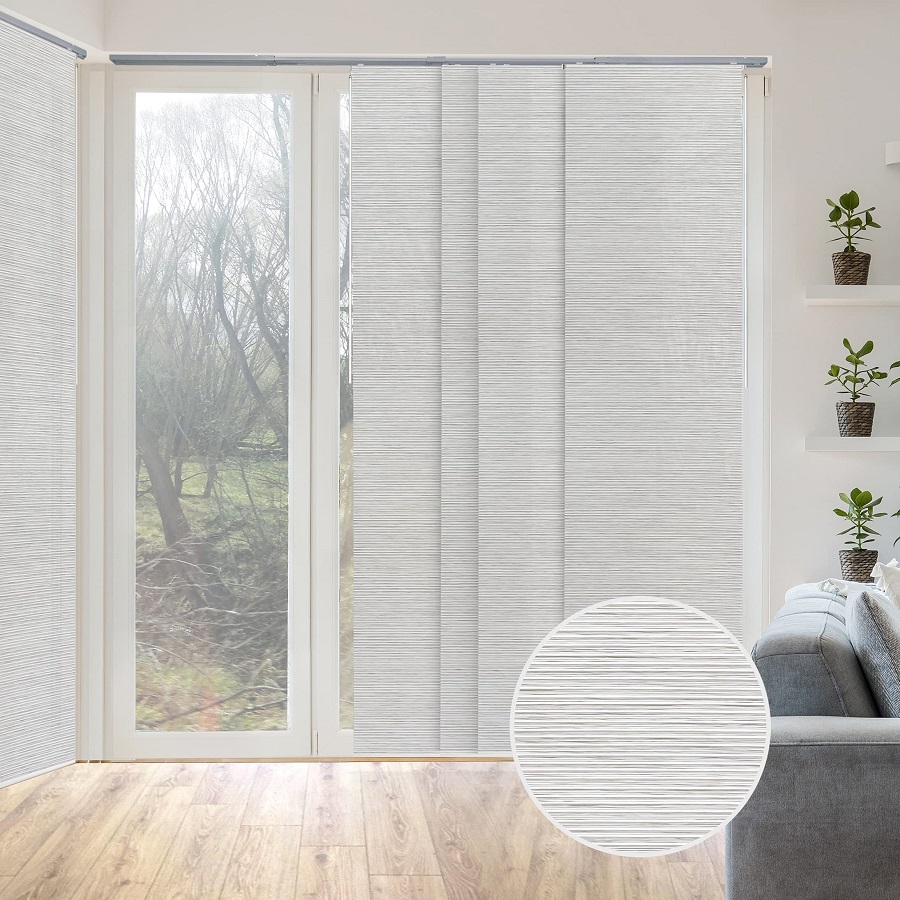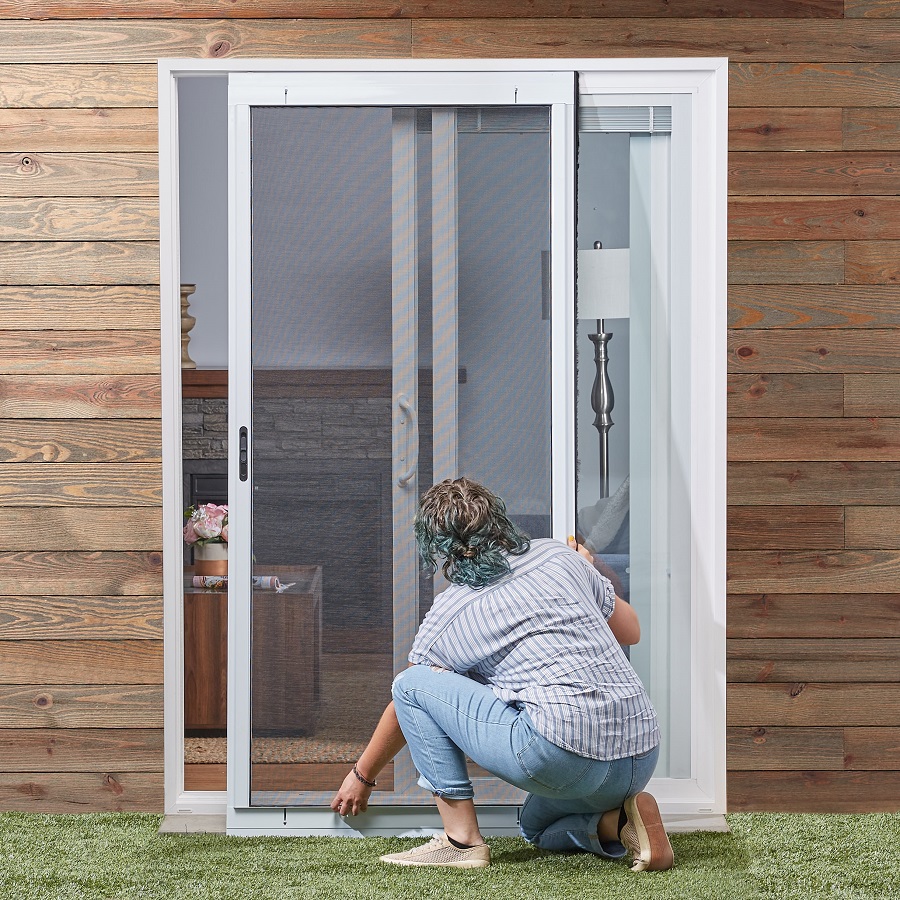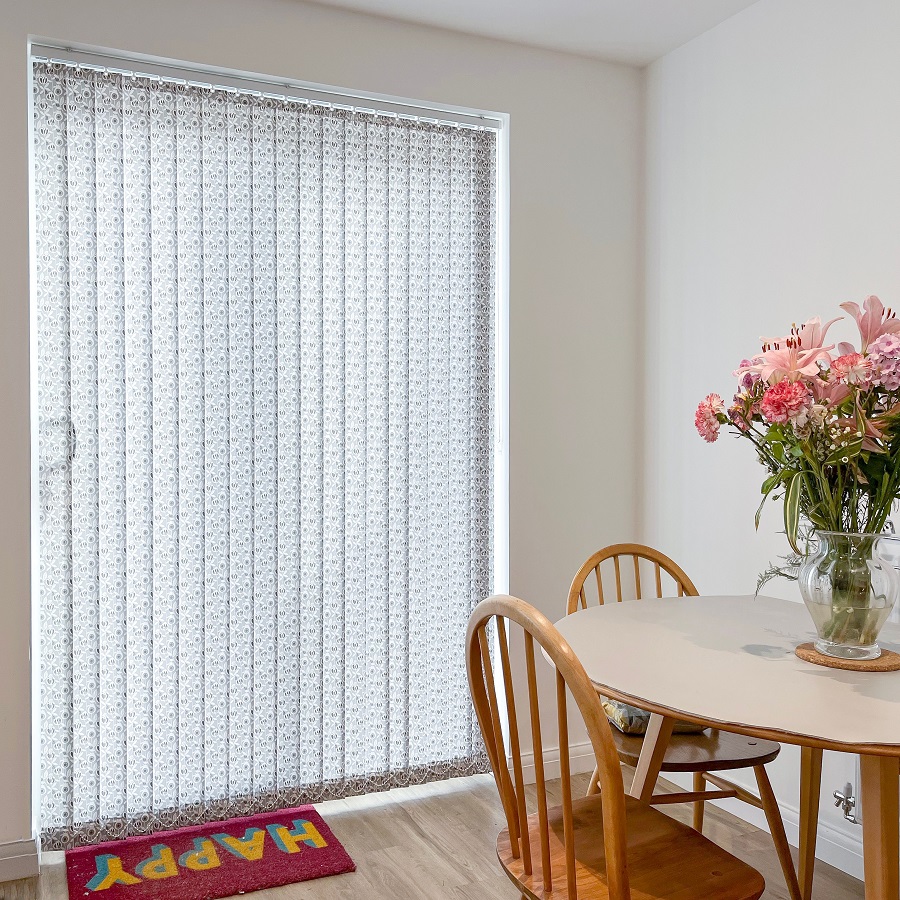Introduction
Sliding doors have become a popular feature in modern homes, offering seamless transitions between indoor and outdoor spaces while flooding interiors with natural light. However, the quest for ample daylight and open views can sometimes compromise privacy. Enter sliding door blinds – a stylish and functional solution that strikes the perfect balance between privacy, light control, and aesthetics. In this guide, we explore the top picks for sliding door blinds, ensuring you make an informed decision that enhances both the functionality and style quotient of your living space.

Vertical Blinds
Vertical blinds are a classic choice for sliding doors, offering excellent light control and privacy. Made from a series of vertical slats, typically in PVC, fabric, or wood, they can be easily adjusted to let in as much or as little light as desired. Their ability to stack neatly to one side when fully opened ensures they don’t obstruct the view or pathway. For ultimate style, opt for fabric vertical blinds in neutral tones or bold patterns to complement your room’s decor.
Panel Track Blinds
Panel track blinds, also known as sliding panel blinds, consist of wide fabric or woven wood panels that slide along a track. This contemporary option is perfect for large sliding glass doors, providing a sleek, minimalist look. With a range of materials available, including solar screens, natural fibers, and even sheer fabrics, panel tracks offer versatility in both function and design. They’re ideal for those seeking a modern, streamlined aesthetic without compromising on privacy.
Cellular Shades
For homeowners prioritizing energy efficiency, cellular shades (also called honeycomb shades) are a smart choice. Their unique cellular structure traps air, providing insulation against heat and cold. Cellular shades designed for sliding doors come with a tracking system that allows them to glide smoothly to the side. Available in various cell sizes, colors, and light-filtering or blackout options, they offer both style and practicality, especially for rooms requiring extra insulation or light blocking capabilities.
Roman Shades for Sliding Doors
Roman shades bring a touch of elegance and warmth to any room. While traditionally used for windows, specialized systems now allow Roman shades to operate on sliding doors. These shades fold neatly when raised, creating a layered, tailored look. Choose from a wide variety of fabrics and patterns to match your interior design. Motorized options make operation even more convenient for hard-to-reach doors.
Roller Shades
Roller shades are a simple yet sophisticated solution for sliding doors. Their clean lines and minimalistic design suit modern and traditional homes alike. Available in various opacity levels, from sheer to blackout, roller shades can be customized to meet your light control and privacy needs. Motorization further enhances their functionality, allowing you to adjust the shades with a remote or smartphone app.
Bamboo/Woven Wood Shades
If you’re after a natural, organic feel, bamboo or woven wood shades might be just the ticket. These shades bring texture and warmth to a space while still allowing filtered light to enter. They’re ideal for rooms with a rustic, coastal, or bohemian theme. Most woven wood shades for sliding doors are designed to glide effortlessly along a track, maintaining the ease of operation despite their larger size.
Considerations When Choosing Sliding Door Blinds
- Measurement: Accurate measurements are crucial for a seamless fit. Consider whether you want an inside or outside mount and measure accordingly.
- Functionality: Think about how you use the space. Do you need complete darkness for a home theater? Or do you prefer filtered light throughout the day?
- Privacy Needs: Evaluate your privacy requirements. Some blinds, like cellular shades, provide better insulation and privacy than others.
- Style and Décor: Your blinds should complement your existing decor. Choose colors and materials that harmonize with your room’s aesthetic.
- Ease of Operation: Motorized options offer convenience, especially for heavy or hard-to-reach blinds.

Determine the Type of Blinds
Before diving into measurements, decide on the type of blind that best suits your needs and style preferences. Popular options for sliding doors include:
- Vertical Blinds: Designed specifically for large windows and patio doors, vertical blinds offer excellent light control and stack compactly when opened.
- Horizontal Blinds: Although typically used for standard windows, wider horizontal blinds can work for sliding doors if you prefer their look.
- Cellular Shades: Also known as honeycomb shades, these provide insulation and a clean, modern appearance.
- Roman Shades: Offer a soft, elegant touch but may not be as practical for frequent use due to stacking issues.
- Panel Tracks: Similar to vertical blinds but with larger fabric panels, offering a sleek, contemporary alternative.
Accurate Measurement is Key
Tools You’ll Need:
- Tape measure
- Pen and paper
- Stepladder (if necessary)
Measuring the Width:
- Measure the exact width of the sliding door frame in three places: top, middle, and bottom. Record the smallest measurement to ensure a snug fit without obstruction.
- If you’re planning to mount the blinds outside the frame for better coverage or light blocking, measure the width of the area you want the blinds to cover, adding a few inches on each side for overlap.
Measuring the Height:
- Measure from the top where the blind will be installed down to the floor or window sill in three places: left, center, and right. Again, use the smallest measurement to avoid any issues.
- For an outside mount, consider adding a few inches to the height to ensure full coverage when the door is open.
Installation Process
Preparations:
- Ensure you have all necessary tools, including a drill, screwdriver, level, brackets, and screws provided with your blind kit.
- Check for any obstructions like handles or trim that might affect installation.
Installing Brackets:
- Decide on the mounting location (inside or outside the frame) and mark the spots for bracket installation using a level to ensure straight alignment.
- For outside mounts, mark the spots slightly above and outside the frame edge to allow for proper coverage.
- Drill pilot holes and attach brackets securely with screws.
Attaching the Blinds:
- Carefully follow the manufacturer’s instructions to attach the blind headrail to the brackets. This step may vary depending on the type of blind you’ve chosen.
- If you’re installing vertical blinds, attach the hangers or carriers to the headrail before hanging the vanes.
- Test the operation of the blinds to make sure they open, close, and traverse smoothly.
Finishing Touches and Tips
- After installation, double-check that the blinds operate correctly and make any necessary adjustments.
- For added child safety, ensure to install cord cleats or choose cordless options to prevent potential hazards.
- Regularly dust or vacuum your blinds to maintain their appearance and function.

The Need for Modern Sliding Door Blinds
Sliding glass doors are a popular feature in many homes, especially those designed to embrace open-concept living and seamless transitions between interior and exterior spaces. However, these expansive panes of glass can pose several challenges:
- Light Control: While natural light is desirable, excessive sunlight can lead to overheating, glare, and fading of furniture and flooring.
- Privacy: Clear glass doors offer little privacy, particularly in ground-floor rooms or those facing neighboring properties.
- Aesthetics: The right window treatment can elevate the look of a room, while the wrong one can detract from its design.
- Functionality: Traditional blinds or curtains may not fit sliding doors well, impede movement, or require frequent adjustment.
Modern Blind Solutions: Innovation Meets Style
To address these challenges, modern blind designs have evolved to cater specifically to sliding doors, offering homeowners a range of sophisticated and efficient options:
Panel Track Blinds
Panel track blinds, also known as sliding panel systems, consist of wide fabric or solid panels that glide along a track, mimicking the motion of the sliding door itself. These blinds provide a sleek, contemporary look and are ideal for covering large expanses. They come in various materials, including solar screens, woven woods, and even sheer fabrics, allowing for flexible light control and privacy settings.
Vertical Blinds with a Twist
Gone are the days of clunky plastic vertical blinds. Today’s versions are made from high-quality materials such as aluminum, PVC, or even fabric, offering improved durability and a more upscale appearance. Motorized options add a touch of luxury, allowing you to control the blinds with just a push of a button.
Bifold Shutters
Bifold shutters offer a classic yet modern solution for sliding doors. These shutters fold neatly to one side when opened, providing unobstructed views and easy access. Made from materials like wood or faux wood, bifold shutters bring a touch of elegance while offering excellent light control and privacy.
Motorized Roller Shades
For a minimalist and tech-savvy approach, motorized roller shades are a popular choice. These shades roll up and down smoothly, operated by remote control or smart home systems, making them incredibly user-friendly. They’re available in a variety of opacity levels, from sheer to blackout, ensuring versatility in both style and function.
Cordless Honeycomb Shades
Honeycomb shades, also known as cellular shades due to their unique cellular structure, offer excellent insulation against heat and cold. Their cordless design ensures child safety and a clean, streamlined look. For sliding doors, wider honeycomb shades can be customized to operate on a track system, maintaining the shade’s energy-efficient properties while accommodating larger windows.
In conclusion
Selecting the right sliding door blinds involves balancing practicality with personal taste. With a myriad of styles, materials, and functionalities available, there’s a perfect match for every home, ensuring both ultimate privacy and a touch of style to elevate your living space.
